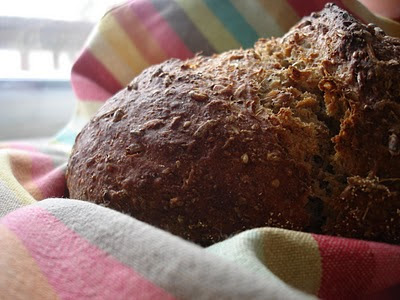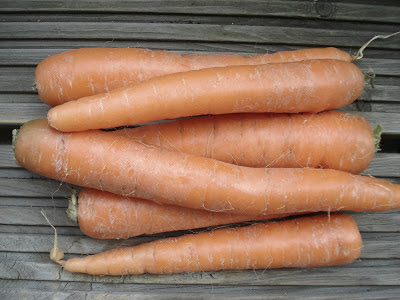Another Go
I've already written about my love of bread (my goodness! That post was practically a novel!), so I will spare you the details. I've also mentioned recently that I have been busy, to a point where I haven't had the time to browse the shelves at my local library or at the bookshop: I've been filling my commute by reading old cookbooks (my mind's been churning too much to concentrate on a novel, even the ones I've already read.) It so happens that the smaller books in my cookbook collection are about bread. I've been dreaming bread: unfortunately, I really could not spare the time necessary to make bread old school.
Obviously, I had to make no-knead bread. And I have: I've been averaging two loaves a week for the past month. It's the bread I used for the French Onion Soup, and for the Stupendous Sandwich. It would also be perfect for a tartine, or for morning toasts. Honestly, I do not understand why more people aren't making their own bread when it is soooo easy. Then it hit me: not everyone owns a dutch oven. Even though they've been popping up in just about every home and kitchen store, they're not exactly cheap. So I set about tweaking the recipe to make it baking-tray-friendly - which also explains my two-loaves-a-week regiment.
The recipe I had previously posted gives a dough that is much too soft and sticky to bake in anything but a dutch oven; the following, on the other hand, is perfect for either cooking methods. If you check out both recipes, you will notice a few glaring discrepancies: most obvious is that the weight measurements for the flour do not add up. It just goes to show that measuring recipes in cups really needs to go the way of the dinosaurs: last year, every cup of flour I weighed out was 130g (I checked each time), whereas all this month, my cups tipped the scales at 140g. I used a combination of regular unbleached flour and whole wheat flour. As far as I know, all no-knead bread recipes floating about in cyber-space are made with all-purpose flour only, so I wanted to see if the method could be applied to a whole wheat bread. It works: the mie (centre of the bread, or crumb) is much denser, not as aerated as an all-white loaf, but it's still a beautiful thing. And the crust is still magically crunchy, even when baked on a cookie sheet.
Even though the whole wheat flour already boosts this bread's nutritional value, I wanted to push it further by adding flaked cereals and seeds; any rolled grain, seeds or nuts will do. A few possible choices are rolled oats, rye or barley; sesame, flax, pumpkin, or sunflower seeds. Finally, this being sprouting season in my world, I had some sprouted wheat berries that needed a new home. Sprouting wheat is really simple, however if it feels a little esoteric, soaking the berries overnight would also do the trick. However, sprouted wheat adds a touch of sweetness and are more easily digested than un-sprouted. (Whatever you do, do not use un-soaked wheat berries, someone might end up losing a tooth!) This is definitely a healthy bread, and it's beautiful to boot.
No-Knead Whole Wheat Bread
Makes one loaf, about 750g/ 1½lbs
Addendum: These exact proportions can be used for bread flour as well. In fact, the crumb will be lighter and airier.
Addendum: These exact proportions can be used for bread flour as well. In fact, the crumb will be lighter and airier.
140g/ 1cup/ 250ml all-purpose flour, unbleached if possible
280g/ 2 cups/ 500ml whole wheat bread flour
12g/ 1¼tsp salt
5g/ 1 tsp dry yeast (or 15g cake yeast)
400ml/ 1½ cups plus 2Tbs water
75g/ ½ cup sprouted wheat, optional
120g/ 1cup mixed flakes and seeds, optional
Coarse cornmeal
In a large bowl, mix flours, salt, yeast, water and sprouted wheat (if using), until everything is thoroughly combined.
Sprinkle cereals and seeds over the dough, and cover with plastic wrap or a damp tea towel.
Leave to rest in a cool, draft-free spot for 12 to 24 hours. (Rising time depends on the temperature in your kitchen: the cooler it is, the longer it will take. In my kitchen, more or less at a constant 18'C/ 65'F, the dough requires a 24hour-rise)
After 6 to 12 hours, mix the grains and seeds into the dough. Scrape down the sides of the bowl, cover and leave to rest until the time is up: the dough will not double in size, however, it will have visibly risen.
To Bake
In a dutch oven: Place empty dutch oven in a cold oven, heat to 250'C/ 500'F. When the oven is hot, remove dutch oven, sprinkle the bottom with cornmeal.
Scrape the dough into the pot, cover and return to oven.
Bake for 30 minutes. Remove lid from pot, and bake for another 10 minutes.
Turn off oven, leave the bread to rest for another 15 minutes before taking it out.
Remove the loaf from dutch oven, and let cool on a rack for at least 30 minutes before cutting into it.
On a baking sheet: Heat oven to 200'C / 400'F. Place a pan filled with 500ml/ 2 cups water on the bottom rack of oven.
Sprinkle baking sheet with cornmeal. Form the dough into a ball by scraping down the sides of the bowl. Gently drop onto the cookie sheet. You can slash the top of the ball with a sharp knife, if you like.
Place sheet on middle rack. Bake for 30-45 minutes. The bread should be a dark, golden brown.
Turn off oven, leaving the bread in for another 15minutes.
Take the bread out of the oven, and let cool for at least 30 minutes.
If you thump the under-belly of this loaf, you should hear a hollow thunk. When you cut into the bread, it will be quite dense and moist, but there should not be any raw spots. This loaf has tremendous keeping qualities: it can sit on the kitchen counter for a few days, and it won't turn into a dry brick. Also the crust will remain quite crisp. Being a fairly moist bread, you might have some trouble getting it to toast into evenly crunchy slices; you can always slice the bread ahead of time, and let them dry out before toasting, or you can toast each slice twice on a lower setting. You no longer have an excuse for not making your own bread.
Bon app'!







Hey Dahlia... just wanted to let you know that I actually made this bread recipe... well, a highly simplified version (no seeds, no sprouted wheat, sadly)... last night. I was stunned by how well it turned out! Just wanted to let you know. I've already doled it out to friends and family... not a large loaf, but an extremely tasty one. Thanks!
ReplyDeleteSo happy to hear about your success Marc! You know, the seeds and stuff are mere garnish, so don't feel sad about not having them on hand to put them in the bread.
ReplyDeleteThis recipe (and the one I previously posted)is also quite versatile: you can play around with the flour proportions, using a combination of more exotic flours such as rye, buckwheat, quinoa, and such. Just make sure you have at least 50% wheat flour (white or whole), otherwise the loaf will be more brick than bread. Another tip, if you happen to have flax meal, use the seeds and sprout proportions, and not the flour proportions. I learnt the hard way that flax meal is not a substitute for flour - and I mean HARD! The bread was really tough!
Happy bread making!